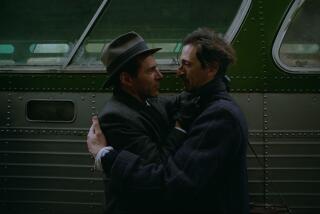Docs are the talk of the teeming town
The Cannes Film Festival is one of the world’s biggest film events, but it never seems to get any bigger. I once asked Giles Jacob, who ran the festival for many years, the reason why, and he said it was simple: The amount of housing a reasonable driving distance from Cannes is finite, and it’s not being increased.
Would that were the case with Sundance.
With the number of newly built skiing condominiums available for film festival rental increasing every year in this fast-growing corner of Utah, Sundance gets so overwhelmingly jammed that this year’s regular visitors were more likely to gossip about the crowds than the films.
On Sundance’s first Friday, for instance, shuttle bus riders numbered 31,000, up from 23,000 the previous year. And the Java Cow, a prime coffee spot on Park City’s Main Street, thought 250 pounds of espresso beans would last the entire festival. They ended up having to order an additional 100 pounds.
One reason people weren’t talking about the films, at least those in the dramatic competition (won by “Quinceanera,” which also took the audience award) is that, by and large, there was not a great deal to talk about.
Though there were some quality pictures in this group, including “Stephanie Daley,” which won the Waldo Salt screenwriting award, and the Ryan Gosling-starring “Half Nelson,” most of the entrants were earnest, well-meaning but lacking in any kind of sustained dramatic appeal.
The Sundance dramatic film with the most pizazz, the crowd-pleasing “Little Miss Sunshine,” was put in the premieres section, not the competition, even though it was made by first-time directors, did not have any A-list stars and cost a non-extravagant $8 million.
But for a festival that likes to sequester its dramatic competition films like cloistered nuns, safely away from the contaminating taint of commercialism, putting a film this popular into the mix was out of the question. This year, more than ever, that seemed a mistake.
Although Hollywood proves every day of the week that commercial success does not ensure quality, Sundance should recognize that lack of commercial potential does not ensure it either. Is it a crime to use the dramatic competition to help films that have a chance of success but are still a longshot in the national marketplace, rather than as a reward for those who really don’t have much of a prayer? It’s a question worth debating.
Another notable dramatic film was South Africa’s “Son of Man,” directed by Mark Dornford-May. Theatrical in the best sense, made with great visual style and layered with African music, it sets the story of Jesus in a contemporary South African township and gives it a liberation-theology political context. The result was some of the most exciting filmmaking of the entire festival.
As always with Sundance, the documentaries outshone the dramatic features, with some festival-goers confessing that Jonathan Demme’s concert doc, “Neil Young: Heart of Gold,” was the most emotional film they saw all week.
“God Grew Tired of Us,” the documentary about Sudan’s “lost boys” that won both the grand jury prize and the audience award, was only one of many Sundance docs that had a sociopolitical context.
Other notable ones included “American Blackout,” a classic muckraking examination of African American exclusion from the polls; “An Unreasonable Man,” a 155-minute attempt to restore Ralph Nader to prominence; and “The Short Life of Jose Antonio Gutierrez,” which examines the story of the first U.S. soldier killed in Iraq.
Also unexpectedly political, and completely fascinating, was “The World According to Sesame Street,” which shows the tricky path the Muppets and company have to tread when they bring their show to areas with intractable problems, such as Bangladesh, Kosovo and South Africa.
This year’s big doc winner, with three awards (direction, cinematography and editing) was “Iraq in Fragments,” a look inside the country that is both poetic and reality-based. Quite different and quietly unflinching, though it won nothing, was “The Ground Truth: After the Killing Ends,” an examination of what the experience of killing does to soldiers.
For the few people who saw it, the most memorable documentary of the festival (and winner of a special jury prize) in many ways was Philip Groening’s 2 3/4 -hour “Into Great Silence.”
Shooting over six months within a Carthusian monastery in the French Alps where silence is the rule, director Groening (who asked to make the film for 15 years before the monks agreed) takes us deep inside this life rather than explain it. His rigorous, meditative, hypnotic film, where every sound feels pregnant with meaning, is a transformative experience, and one that was especially welcome in this most hectic of festivals.
More to Read
Only good movies
Get the Indie Focus newsletter, Mark Olsen's weekly guide to the world of cinema.
You may occasionally receive promotional content from the Los Angeles Times.











